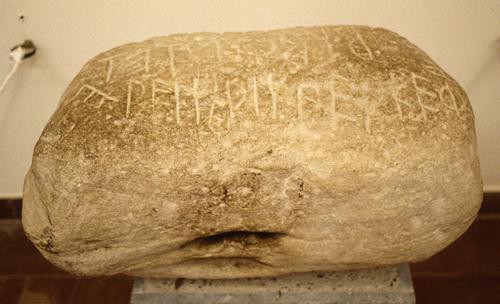stone Lifting
Lifting stones are heavy natural stones which people are challenged to lift, proving their strength.
The lifting of Scottish Stones is of keen interest to many strength athletes across the world.
Some lifters satisfy themselves with lifting atlas stones. Others progress to natural stones in their local area. The truly insane get on a plane, then in to a car, and ultimately find themselves in a muddy field in the Highlands of Scotland with an audience of bored sheep and a lump of granite between their legs.
Often that disobedient lump of rock defies their grasp. Apparently it is unaware that they have impressive barbell numbers. It clearly does not know that they are in ‘beast mode’ and planned to ‘rip it’, ‘smash it’ and ‘dominate it’.
The stones don’t care. The sheep don’t care.
It’s a disappointment that can be avoided with careful preparation. Therefore, this article will focus mainly on the ‘round/oval’ stones in Scotland and how to train for them. Let us start by take a look at some of the hand positions in successful stones lifts.

Stones
Stones are one of the most natural objects to lift. Before you had weights, you had stones. These stones were a huge part in showing how strong a man was. In Scotland and in Wales, it was a rite into manhood. Being able to lift a stone, was a sign of basic fitness. Lifting until the waist was a minimal requirement. It’s fascinating how deeply rooted in different cultures stone lifting is, given that the practice of lifting stones is hard to find.

Lifting bags of sand, stones, or any other heavy objects have always been a necessity in human life. Being strong was a practical skill. Being able to hunt, to transport the grain bags, to build houses, to fight in an army… For all of these skills, strength was a necessity. Stone lifting was an objective way to compare yourself to your friends, or to other clans. You could lift it, or you couldn’t.
Stone lifting has been popular all around the globe for hundreds of years.
Let me give you some examples of historical stone lifting, although the legacy
How To Train For Such Lifts
Many a strongman has come undone by assuming atlas stones are the same as the stones he will face in Scotland or elsewhere. As you can see from the pictures/video above the pickup is entirely different. The contact points on the forearm are smaller in size and do not allow a lot of sideways squeezing pressure that is essential to picking up a McGlashen stone.
Training for stone lifting must be multifaceted. Simply working on improving your overall strength in a gym will not suffice, however, it must also not be ignored. A compromise must be reached between developing the necessary base of strength required to lift the kinds of weight demanded by the unwieldy beasts, and the requisite skill set and ‘implement’ practice needed.
Developing the necessary base of strength should start with the basic compound movements that any strength athlete is familiar with. Squats, Deadlifts, heavy rows, and for the sake of overall strength development, overhead pressing & bench press work.
Impressive back and hip strength is the primary requirement. In fact, the entire posterior chain should be a huge focus. This is where squatting and deadlifting in their various forms are important. Squats, front squats, SSB squats, Deadlifts, Trap bar deadlifts and stiff-leg deadlifting are weapons of choice.
Heavy dumbbell rowing would be number one for upper back assistance development, followed by barbell rowing, and seated rowing among others.
Specific arm training I personally don’t consider especially important. I do believe direct grip work can help however, as can some direct abdominal work. Grip training will be addressed later on in this article.
Specific implement training for natural stones can be difficult to achieve as each and every stone in the wilds is completely unique and as indicated above, presents its own individual set of challenges.
Exposing oneself to as many different stones in training as possible is a great start. It will help an athlete understand the great variance to be encountered on natural stones and stones in general, including atlas stones.
Similar set/rep schemes as barbell training can be applied to stone training without over complicating things. Access to stones can be an athletes biggest limiting factor, though lifting with any stone is better than none at all.
Looking at sets of between 5-10 reps with moderate weight stones and lower 2-3 rep sets for heavier stones is a good guide. Loading onto platforms of varying heights, shouldering or simply triple extending with the stone are all perfectly acceptable methods.
Stone training should be restricted to at most twice per week if other events and regular training in the gym are also being performed. More than this will become too taxing on tendons and injury will surely follow. Personally I would never train stones more frequently than once per week.
Natural Stones and certainly any stones of renown, will be lifted with the assistance of chalk only. Due to the nature of the majority of natural stones, the use of tacky is frivolous anyway and will likely be more of a hindrance than a help. Woe betide any person who attempts to touch a traditional Scottish lifting stone with tacky.
Natural Stones and certainly any stones of renown, will be lifted with the assistance of chalk only. Due to the nature of the majority of natural stones, the use of tacky is frivolous anyway and will likely be more of a hindrance than a help. Woe betide any person who attempts to touch a traditional Scottish lifting stone with tacky.
There are multiple ways to lift stones and each style of lift should be trained if desired to be attempted in the wild. Examples may include shouldering, extending, overhead pressing, bear hugging, loading and even walking with the stones.
Below is a compilation video of natural stones being lifted. It demonstrates a great variety of surface conditions, stone shape and size, and lifting methods.
Although none of these are Scottish lifting stones, the principle is the same. Lifting stones as mother nature made them, where mother nature placed them, with little or no assistance save for your own strength.
goes far further than that.
